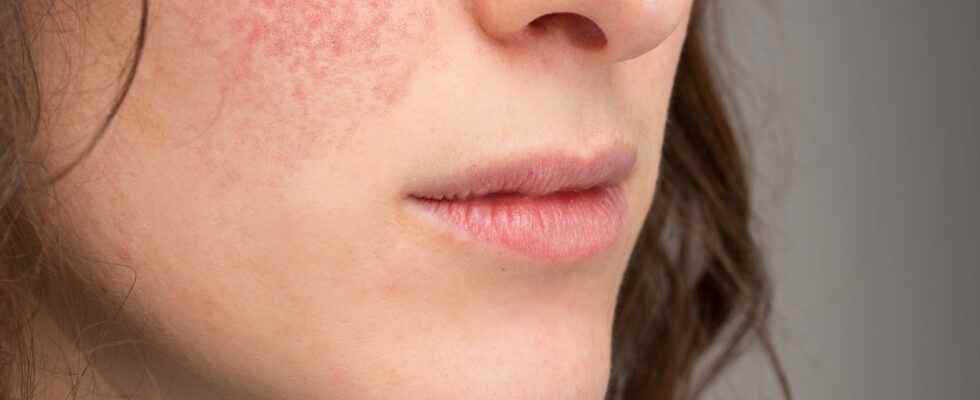When exposed to cold, your skin is covered with itchy red patches? The diagnosis of cold urticaria is confirmed by the ice cube test, which also makes it possible to assess its severity.
Cold urticaria is a rare pathology that affects about 2 to 3% of cases of urticaria. She is caused by cooling of the skin or mucous membranes on contact with air, water, cold objects or frozen food.
In 90% of cases, no cause is detected: it is said to be idiopathic. The treatment combines protection against the cold and antiallergic drugs. In the remaining 10%, it can be caused by:
- A infection, such as HIV, hepatitis B, or infectious mononucleosis. Serological tests for Hepatitis B and C, infectious mononucleosis, hepatitis and HIV can be performed
- Some medications like penicillin, antifungalsangiotensin II receptor blockers, oral contraceptives and griseofulin.
- Some very rare cases of cold urticaria are of origin hereditary. Symptoms may persist for several days. There are delayed forms which appear up to nearly 20 hours after exposure to cold.
“On the exposed areas will appear in a few minutes red and swollen patches, accompanied by severe itching. They can disappear very quickly or remain for several hours. “, explains Dr. Monique Quillard, general practitioner. In parallel, demonstrations like headaches, abdominal pain or tachycardia occur in 30% of cases. On the other hand, the onset of anaphylactic shock can occur.
The ice cube test is done by placing an ice cube wrapped in a plastic bag on the forearm for about 5 to 20 minutes.
Hives occur on areas exposed to cold such as face, neck and hands but the lesions can sometimes extend over the whole body. Some mucous membranes can also be affected such as mouth and esophagusespecially following the ingestion of a very cold drink.
“Cold urticaria is not dangerous but there is a serious form, with angioedema, says Dr. Quillard. There is then a risk of discomfort and anaphylactic shock, especially when this urticaria affects the mucous membranes. “. Better consult your doctor at the first signs of the disease to make sure it is benign.
The diagnosis of cold urticaria is confirmed by the test at ice Cube which also makes it possible to assess its seriousness. This test is done by placing an ice cube wrapped in a plastic bag on the forearm for about 5 to 20 minutes. The test is considered positive when a papule appears within 15 minutes after the end of contact. Patients with a reaction occurring rapidly in less than 3 minutes are at high risk of having a severe reaction such as anaphylactic shock.
Only About 20% of people with cold urticaria have a negative ice cube test. Variations of the ice cube test can then be performed in order to make the diagnosis: the duration of the ice cube test can be extended, the forearm can be immersed in cold water or the test can be performed in a cold room. These tests require close monitoring due to a risk of anaphylactic shock. The presence of a resuscitator is recommended during the practice of this test.
The most important thing is prevention, by wearing clothing against the cold, in particular gloves, but also by avoiding cold baths and the consumption of frozen drinks or foods.
In other cases, the treatment is based on:
- The taking of medication. “It depends on the intensity and severity of the manifestations of cold urticaria: when the manifestations of cold urticaria are moderate, a antihistamine treatment taken daily or before exposure is advised. The recommended dose varies according to the result obtainedsays our expert. It is sometimes necessary to consider higher doses and to combine two different antihistamines “. In the event of a severe form, in particular with the onset of asthma, anaphylactic shock or when the ice cube test has become positive rapidly in less than 3 minutes, it is vital to have an auto-injectable adrenaline pen on you.
- In some cases, a desensitization possible, by gradual exposure to cold. This is done in a hospital setting.
- The Natural Healing : “symptomatic treatment at the time of the crisis can be prescribed: Histaminum 15CH, at the rate of 5 granules 3 times a day for 4 or 5 days / Urtica urens 9CH and Dulcamara 9CH, 5 granules of each every hour at the time of the crisis, to be spaced out as soon as there is improvement, 3 doses per 24 hours until the rash disappears “, prescribed Dr. Quillard.
In children there are many viral pathologies that can give this kind of eruption. “From the first symptoms, talk to your pediatrician: you will have to do a medical check-up to make this diagnosis, reassure the parents and offer treatment. “, recommends Dr. Quillard.
Thanks to Dr Monique Quillard, general practitioner.
